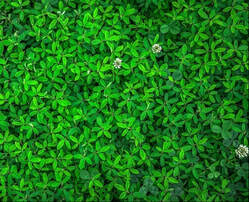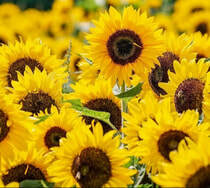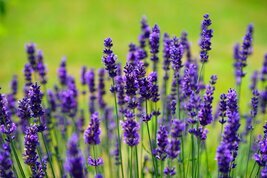The color green is one of the most welcome signs of spring, followed closely by the return of the red-breasted robin, bright yellow forsythia, and fragrant purple hyacinth in bloom. Colors spark feelings and trigger inspiration – especially for the gardener.
It's no wonder our planet is so full of colorful life: color in nature always serves a purpose. Color can help a species to either “stand out from the crowd” and attract pollinators or to provide a protective camouflage from enemies. In human beings, color --and color combinations -- have a powerful effect on one's mood.

Let’s go back to green, a color associated with renewal, tranquility, and grounding. Green is easy to find in our gardens. Most weeds are green! Now imagine a conifer woods full of pines, fir, and hemlock, or a lush shade garden of hosta, ferns, and vinca. It would be easy to sit and relax in this space, meditate, journal, or read. Green is inviting but subtle, not showy, and serves as an excellent background to the bright colors we love. For example, red.

On the color wheel, red is the complementary color of green. The plant kingdom is full of many red flowers, including the popular red rose. When you are feeling tired or sad, red can be energizing and motivating. Planting spring blooming red tulips or summer blooming red dahlias can add a lot of flair to both your garden beds and your attitude!

The color most associated with cheer and happiness is yellow. Who doesn’t smile when seeing spring daffodils in May or giant sunflowers in August? Yellow also represents courage and friendship and promotes feelings of trust, youthfulness, and ‘fun’. An old-fashioned combination of yellow marigolds, calendula, zinnia, or petunia flowers in white hanging baskets is simple and sweet. Bring on the lemonade!

Colors reputed to be the most healing are green, blue, and violet. Though true blue flowers are not easy to find, there are a few, such as blue stars (Amsonia), great blue lobelia, and forget-me-not. Violet and purple shades include lilac shrubs, iris, flowering onion, pansy, salvia, clematis, and aromatic lavender. These blue and purple flowers nestled among green foliage promote a tranquil and calming feeling. Add some gray or silver plants such as artemisia for extra shimmer on a moonlit night.

Other colors to mention include orange, which, like yellow, can brighten one's mood. It pairs well with dark purple, green, and black for a fun and sophisticated vibe. Pink is an easy color to find in the garden and most associated with gentleness and good health. Pink pairs well with light yellow, silver, and creamy peach, and this combo can enhance a relaxing and romantic mood. Combining bright pinks, fuschia, purple, indigo, orange and off-white can enhance a creative and modern vibe that shouts “Work hard! Play hard!
Be mindful of the colors and combinations of colors you chose! They can be both healing and appealing, whether in a bouquet or in a garden.
